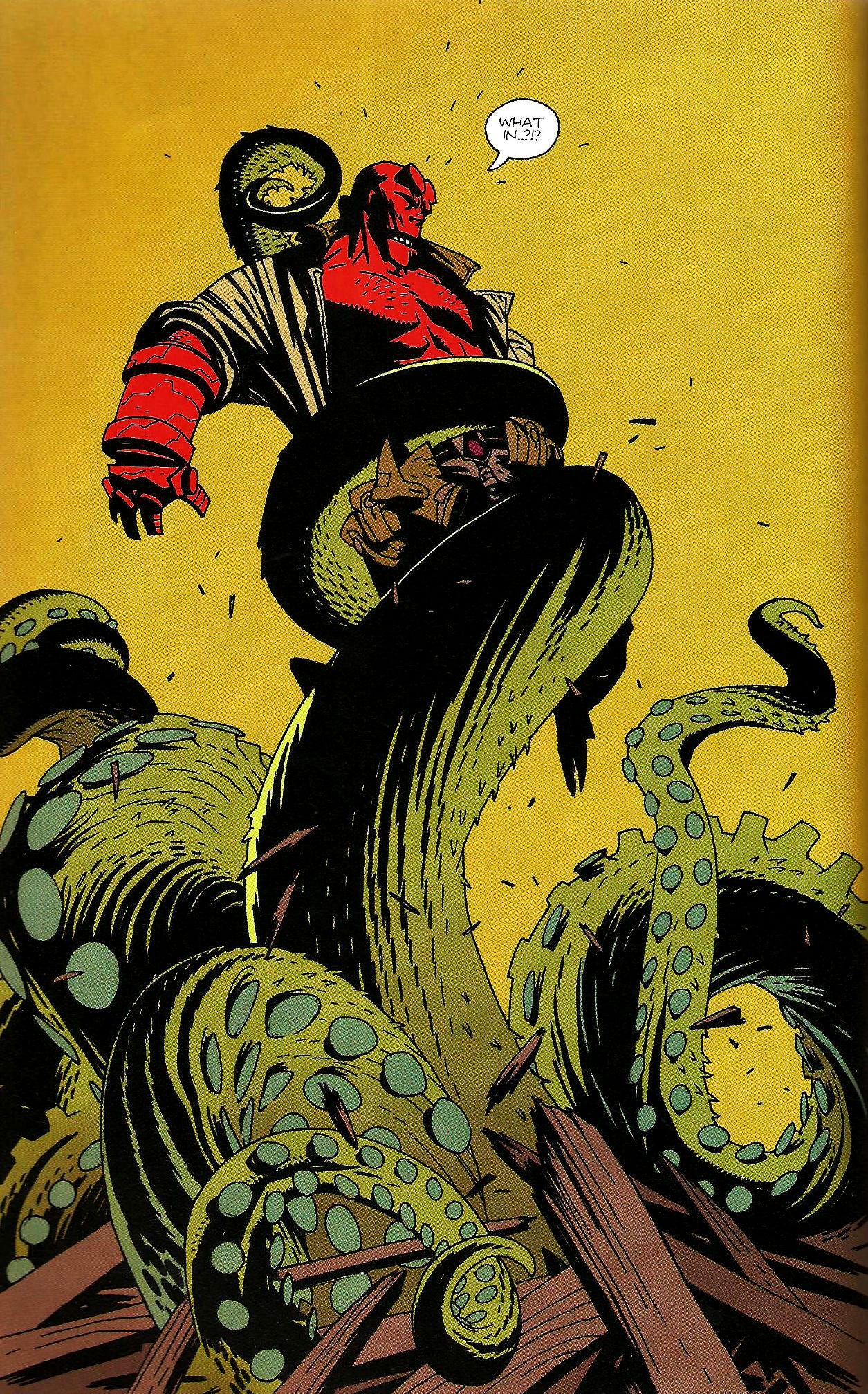The pulp revival, of which the Bizarchives and this fine Substack are a proud part, has been brewing for much longer than people realize. Neo-pulp films like Who Framed Roger Rabbit, The Rocketeer, The Shadow, and the execrable Dick Tracy all appeared during the same late ‘80s, early ‘90s epoch. A similar zeitgeist held true in the comic book world, which is the direct heir of the pulps anyway. To my mind, the chief proponent and creator of the pulp revival in the funny books was and remains Mike Mignola.
But who is Mike Mignola?
Online sources say he is in his early 60s, a native of Berkeley, California, and a long-time artist in the comic book industry. Mignola is also a genius. His greatest and most noteworthy creation is Hellboy and the entire Hellboy Universe. The first Hellboy story arc, Seed of Destruction, is pure pulp and features evil Nazi scientists hellbent on destroying the world, demon children, Rasputin, and the never-ending war between good and evil. Seed of Destruction is not only the debut of Hellboy, but it is also the debut of the BPRD, or Bureau of Paranormal Research & Defense. The BPRD are ghostbreakers with a federal government budget, and their offensives often target Mignola’s version of Lovecraft’s Great Old Ones known as the Ogdru Jahad. Other times the BPRD travel across the world and waste frogs. Budget requirements are budget requirements, and bureaucrats gotta eat.
Since its debut in 1994, the Hellboy Universe has continued to expand. In 2007, one of the more interesting characters in the universe arrived and made an immediate impact. Do not let the goofy name fool you—Lobster Johnson is a great character, a fun read, and a living love letter to the original era of pulp fiction. First appearing in Iron Prometheus, Lobster Johnson has gained a major cult following among Mignola fans and comic book readers alike. Aside from graphic novels, there are also full-length novels and novelettes featuring the character and his band of agents.
But who is Lobster Johnson?
That question is better answered with some descriptions. The common story is that he is a reclusive Swedish-American millionaire in Depression-era New York City. He is a vigilante dressed in a leather get-up, including a leather flight helmet and googles. He is a former professional wrestler. He knows his way around a zeppelin. He wields dual .45s, and whenever he finishes with a criminal, he marks their forehead with his distinctive mark—a burning lobster claw. He surrounds himself with a cast of hard-boiled characters, all of whom are ready to help out their boss at a moment’s notice. I ask you: is there anything more pulp than this?
Members of the Lobster’s crew include: redheaded driver Lester; mechanic and future flier for the Republic of China Air Force Harold “Harry” McTell; bespectacled technician Robert “Bob” Isherwood; and the “tunnel rat” TNT man Bill. Although not an official member, Cynthia “Cindy” Tynan of the Herald Tribune gets down and dirty with the boys, and she uses her contacts in order to aid Lobster Johnson in his vigilante war against his enemies in the underworld. And boy what enemies does the Lobster have! The biggest baddie is Memnan Saa, a deathless occultist who seeks to harness the immortal power of vril. Memnan Saa is not too picky when it comes to who he works with, and the black magician spends much of the 1930s teaming up with German spies and saboteurs. There is also the Japanese spy and criminal known as the Crimson Lotus, who uses her seemingly supernatural powers to target both the Lobster and Kuomintang-affiliated Tongs in New York’s Chinatown. Throw in Nazi zeppelin pilots, mad scientists, a dwarf crime boss, cannibal killers, and amoral treasure hunters and you have a fairly rough idea of the type of people Lobster Johnson fights.
Pulp lovers will immediately recognize Lobster Johnson as a pastiche of the Shadow. Both share a similar backstory, plus Lobster Johnson’s work on behalf of the U.S. government in the run up to World War II is not disimilar from the Shadow’s own intelligence work, including his time as an American volunteer in the French Air Force during World War I and his later operations for a secret monarchist organization in Russia. However, unlike the Shadow, Lobster Johnson has a storyline death. The masked vigilante dies in March 1939 at Hunte Castle in Austria. The brave Lobster expired trying to stop the head-in-a-jar Nazi scientist Herman von Klempt from launching a massive missile attack. Again, how can you not love this stuff?
Lobster Johnson pops up quite a bit in Hellboy’s cases as a ghost still hungry for justice. It seems that a pulp vigilante’s work is never done. Besides, who would want to hang around Heaven forever when there’s plenty of punks to shoot on Earth? I for one welcome pulp vigilantes and hope they come to my neighborhood.
The Lobster Johnson graphic novels and one-off stories all feature Mignola’s usual spare prose and emphasis on bold action panels rather than overly explanative speech bubbles. Couple this with the Expressionism-meets-Art Deco style and you have the pinnacle of pulp happiness. That’s what Lobster Johnson is—a sincere appreciation for the classic pulps packaged towards serious comic book fans.
If you want to get started with Lobster Johnson, then I suggest picking up Iron Prometheus first and then reading the graphic novels in order. Or you could save your money and wait for April 5 when the Lobster Johnson Omnibus Volume 1 comes out. Either way, you, pulp fan, should just bite the bullet and start reading this series ASAP. Who knows? Maybe you’ll be inspired to form your own crime-fighting gang. Get enough steam and you can run for mayor, at which point you can solve the crimes that you yourself commit.
But let’s not get too ahead of ourselves. Just stick with Lobster Johnson for now.






